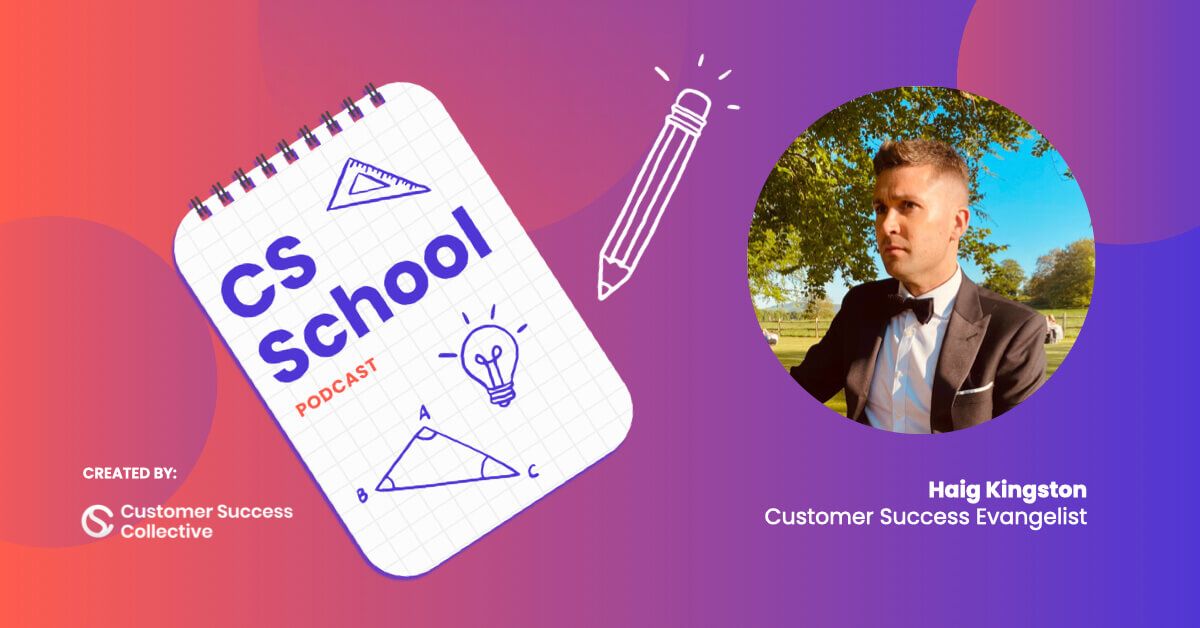This article is based on an episode of our podcast CS School. Catch up on this episode and other episodes right here.
Understanding the essence of “value” and its role in customer success is more critical than ever. I've seen how redefining and navigating the concept of value can transform relationships with customers, fostering trust and setting the stage for continuous growth.
In this article, I’ll take you on a value-centric journey, exploring :
- The five pillars of customer success,
- How to measure value realization,
- Introducing value discussions,
- The necessary steps to create a value-led customer success framework,
- How to put value at the heart of everything you do,
- A case study of a value-led framework, and
- What post-value realization looks like.
Prepare yourself for a value-led rollercoaster, as we dive deep into the world of value realization and its transformative impact on customer success.

The five pillars of customer success
Throughout my journey, I've adopted a unique philosophy of customer success, which I've condensed into a framework I refer to as the "Five pillars of customer success."
This framework uses the letter “R,” to symbolize the five components: relationship, retention, revenue, reference, and realization. The reference here signifies advocacy, while realization refers to value. I am of the firm belief that any customer success team armed with this framework is set for success.
Throughout my career, I've always tried to identify these elements and incorporate them into my work. It's this same value realization and customer advocacy that we're here to talk about today, and I believe it's a critical aspect that any customer success team needs to focus on.
The meaning of value in business and customer success
Understanding what “value” means in the context of business and customer success teams is crucial. While the definition of value may vary based on the industry or the company you're working with, it's fundamental to interpret it from the customer's perspective.
A customer-centric view
The key here is realization.
Start by understanding what your customer aims to achieve by partnering with your business and using your products or services. This comprehension is essential because the meaning of value can differ vastly depending on the individual customer's needs and aspirations.
In my experience, I've seen customers who desired a stable solution amidst the uncertainties of the COVID-19 pandemic, while others sought to re-evaluate their investments. Therefore, it's crucial to accurately determine your customer's needs because, at its core, it's all about the customer.
The decision to partner with your business should ideally lead to a measurable outcome for the customer. This outcome could take various forms – financial, risk mitigation, digital transformation, or even improving the experience for their end customers.

Understanding various forms of value
The return on investment (ROI) piece, particularly from a financial perspective, will always be a prominent component of customer success. Especially in our current economic climate, customers want a substantial ROI for their money. However, the idea of value extends beyond just financials.
For instance, in the payroll and HCM industry where I work, saving time for HR and payroll teams is a significant form of value. These teams are constantly under time pressure, and anything that helps them speed up their weekly, biweekly, or monthly payroll cycles is immensely valuable.
Similarly, reducing operational risk could be a valuable outcome for many customers. How can your software, or how can partnering with you, help mitigate risks for your customers?
Tying value to products and services
All of this should circle back to your product or service. The central question to consider is, what value does your offering bring to your customers, their users, their stakeholders, and their industry peers?
Having a clear understanding of these aspects will certainly facilitate more effective value discovery conversations at an early stage of the customer journey. However, it's essential to remember that every customer wants to see a measurable outcome, and what that looks like can significantly differ.

Measuring value realization: The essential metrics
Achieving value realization is one thing, but effectively measuring it is another. Metrics, although they may vary from team to team and customer to customer, can serve as crucial indicators of value realization.
Product adoption and stakeholder engagement
One key approach to measuring value is to track product adoption and the overall health score of the customer relationship.
Equally important is stakeholder mapping and the level of engagement with various stakeholders within your customer's organization. However, it's crucial not to overcomplicate this process. We must simplify value realization and build a strong foundation, starting from the ground up.
The ultimate goal is to create a value or business transformation story. This story will enable you to convert the quantifiable achieved value into something tangible for your customers to reflect on, promote, and recognize the returns of their partnership with you. The emphasis on “partnership” here is paramount.
Expected vs. achieved value
A valuable method I've used to track value involves dividing the process into two clear parts: “expected value” and “achieved value.”
- Expected value: This allows your customer to dictate through strategic initiatives that all customer success teams should be tracking. It helps you understand what they expect to receive within a certain timeframe.
- Achieved value: This captures what your customer has managed to accomplish up to a given point.
By categorizing value this way, you can gauge your engagement level with your customers more effectively, whether that's on a monthly or a quarterly basis.
To illustrate, in my current role, we focus on quarterly initiatives. We consider what issues the organization is working on, the end goal, the end date, and the outcome of that initiative. By categorizing value into “expected” and “achieved” sections, you can track value more effectively and move accomplished objectives into the achieved section. This method helps to build out the customer's value story.
By capturing this quantifiable value that's been agreed upon and achieved through your engagement, you can create a more comprehensive picture. It’ll empower the customer success team to monitor and manage customer health, repivot as necessary, and engage with various stakeholders to ensure customer success.
Different stakeholders within your customer's organization will have varying perspectives on value, and you'll need to adjust and re-engage with each stakeholder level to ensure alignment. There are various metrics to consider, such as product adoption, but the distinction between expected and achieved value can serve as a powerful tool in your value realization strategy.
Introducing value discussions
Having a value-led customer success framework can be an essential tool in assisting customers to reach their goals. However, establishing this framework doesn’t happen instantly.
When dealing with multiple customers, it's important to consider when and how to introduce the concept of value. This discussion should ideally begin at the point of sale and continue throughout the customer relationship. Value expectations can be gauged through initial interactions with the sales team and during implementation.
A standardized governance framework can support this, with tools such as introductory calls, monthly partnership calls, quarterly business reviews, and executive interviews. However, it's vital to remember that the focus should be on the customer's value, not solely on the organization's objectives.
One approach to understanding customer value is to engage customers in a value whiteboard session. Utilizing tools like Microsoft Teams' whiteboard feature, customers can outline what value looks like for them, what they want to achieve, and how that is represented in their partnership with your organization.
This visual aid allows customers and the customer success team to identify key areas of value and track progress. The team can provide industry benchmarks, offer suggestions based on other customer success stories, and expand on customer insights to build a comprehensive understanding of value.
This customer-centric approach allows customers to express their understanding of value, and the customer success team can then align that with the organization's value drivers.
The role of the customer success team is to facilitate these discussions, bring the value whiteboard to every meeting, and allow for expansion and reassessment as needed.
This active involvement in value realization positions the team as a partner, helping the customer achieve their goals and maximize the value of their partnership.

Creating a value-led customer success framework
A customer success framework is a strategic approach for managing and improving customer relationships, with the goal of increasing customer loyalty, reducing churn, and driving growth for the business. To implement a value-led customer success framework, certain steps and factors should be considered:
Have a vision and philosophy
As a leader in customer success, you need to articulate a vision and philosophy for the function. This may vary based on your business context, but it should align with the overall organizational goals.
Establish a governance framework
This involves defining who participates in what call, when, and what the outcome of each call should be. This framework should be customer-centric, focusing on monthly partnership reviews or Quarterly Business Reviews (QBRs) to track progress toward achieving the defined value.
Create a health matrix
A robust health matrix can help monitor customer health beyond the conventional "red-amber-green" status. Evolving this into a more nuanced system can provide a more definitive approach to understanding customer sentiment.
Monitor risks and potential churn
It's important to track potential risk factors that could lead to customer churn. This involves understanding your customer and their needs, plus identifying areas of possible dissatisfaction.
Stakeholder mapping
Understand who the key stakeholders are within your customer's organization and who you need to engage with to drive success.
Develop success plans
These are critical tools in customer success, outlining objectives, strategies, and tactics for achieving the defined value. They serve as a roadmap for the customer's journey.
Track key metrics
Depending on your business model and objectives, tracking Net Revenue Retention (NRR) or Annual Recurring Revenue (ARR) can provide insights into customer loyalty and the financial health of the customer relationship.
Be consistent and transparent
The approach to customer success should be clear, consistent, and transparent. This builds trust, fosters long-term relationships, and ensures that customers understand the value they are receiving.
Implementing a value-led customer success framework requires thoughtful planning and execution. However, by focusing on delivering value and measuring the right metrics, businesses can create stronger relationships with their customers, leading to improved customer retention and growth.
Putting value at the heart of your customer success framework
Putting value at the heart of your customer success framework means making it the primary focus of every interaction with your customer. It’s important to consistently articulate and demonstrate the value your product or service is providing to your customer. Here's how you can ensure value is at every step of your customer success journey:
Begin with value
Start the customer journey by discussing value as early as possible. This includes identifying what the customer wants to achieve and how your product or service can help them reach these goals.
Customer input
Allow customers to have a say in defining what value means to them. This could involve regular feedback sessions, surveys, or other methods of gathering customer insights.
Regular discussions
Make value a regular topic in your communications with customers. This should not be a one-off discussion but a recurring theme throughout the customer journey.
Make the customer a "rockstar"
Aim to elevate your customer's status within their own organization through the value they're deriving from your product or service. Show them how using your product can enhance their reputation, enable them to deliver on their goals, and secure further investment.
Showcase achievements
Regularly highlight the value that your product or service has delivered. This can serve as a reminder of why they chose your product in the first place and reinforces the benefits of continuing the partnership.
Advocate for the customer
Always represent the customer's interests within your own organization. Make sure their needs and perspectives are heard and taken into account when making decisions that could affect them.
By incorporating these steps into your customer success framework, you ensure that value is at the heart of your interactions with customers. It's about making the customer the focal point of your efforts and demonstrating your commitment to helping them achieve their goals.
This, in turn, encourages them to invest further in your products or services and deepens the partnership between your businesses.

Utilizing customer data for a value-led customer success framework
To create a value-led success plan and framework, customer data is integral. It offers deep insights that can help deliver value to customers, help them achieve their goals, and foster a fruitful partnership. Here's how to organize and maximize the use of customer data:
Develop a robust success plan
Create a comprehensive success plan that acts as a "CSM Bible" containing all necessary information about the customer. This may include details about their health scores, financials, and salient points that may need to be highlighted to your executive team. Additionally, this success plan can be a place to track value and your initiatives.
Use customer success platforms
Leverage customer success platforms and tools that allow you to maintain and share a success plan with your customers. These tools enable a level of transparency and collaboration that customers appreciate. You can even have a shared success plan where both you and the customer can contribute, comment, and work together towards achieving the desired value.
Organize data based on specific criteria
Depending on the type of industry you're in, you may want to organize your customer data based on various criteria. This could include the size of the customer, their brand value, their annual contract value, or their net revenue retention (NRR).

Combine soft skills and data analysis
While organizing and utilizing data is important, it shouldn't take away from the empathy and relational aspects of the customer success role. Combining data-driven insights with human traits like empathy can lead to a more effective customer success strategy.
By properly organizing and capitalizing on your customer data, you can not only create a value-led customer success plan but also work more efficiently towards achieving your customers' goals. This not only helps you deliver value to your customers but also strengthens your partnership with them.
Case study: Implementing a value-led customer success framework
In a previous role, I worked directly with one of the UK's biggest retailers to implement a value-led customer success framework that led to significant improvements in the customer's experience.
We first identified the key stakeholders and the product set they were using. By partnering closely with our sales operations team and sales counterpart, we understood the background of their business, the reason for their investment in our services, and their growth plans.
Next, we developed a robust and strategic governance model with regular touchpoints and defined deliverable outcomes. This model helped us identify the right stakeholders and ensure their involvement in the necessary conversations.
Over time, and through consistent engagement and demonstrating value, we gained the trust of the customer, allowing us to have a seat at the executive table. This presented us with an opportunity to discuss and demonstrate the key value we delivered and how it contributed to their business transformation.
With the help of our marketing teams, we built a value story for the customer, showcasing the significant value we had delivered. We used their feedback and comments and supplemented this with statistics that highlighted the tangible outcomes of our partnership. For example, their employees spent around 79 seconds per day on our mobile app, which, for a company with close to 14-15,000 employees, was a substantial figure.
By presenting a clear business transformation story, we demonstrated how our partnership saved them money, reduced their operational risk, and improved their productivity. This success story was then used internally by the customer to highlight the importance of our partnership and promote their internal department.
This case study exemplifies how a value-led customer success framework can lead to a highly fruitful partnership, improving the customer's experience, and promoting their business transformation.
Future focus: Post-value realization
Once a customer has realized value and achieved their initial goals within a value-led framework, it doesn't mean the journey ends there. Instead, it's almost as if the cycle starts again.
Customers will have new strategic initiatives, goals, and challenges that they want to tackle, and as a customer success team, our job is to continue supporting and driving them toward their new goals.
One potential next step could be expansion within the same account, or cross-selling additional modules or features of our product that we've identified could bring further value to them. This is often based on understanding the customer's broader ecosystem and identifying areas where our products or services could replace or complement existing solutions they're using.
Another area of focus post-value realization could be customer advocacy. This could involve encouraging satisfied customers to share their success story, perhaps by presenting at our events or through marketing activities such as case studies or video testimonials. Advocacy not only provides social proof and helps in attracting new customers, but also strengthens the relationship with the existing customer.
Most importantly, the pursuit of customer value is a continuous journey. It’s about asking:
- "What can we achieve next?”
- "What are you looking to do as an organization that we can support you with?"
Our customer success teams need to continuously build trust, identify new areas of expected value, and support our customers in achieving their ever-evolving goals. The key to success is maintaining a consistent, proactive, and customer-centric approach.

Customer Success Festival
For more insightful deep dives like this, be sure to check out our customer success events calendar.
Experience a whirlwind of groundbreaking ideas from the masterminds shaping customer success strategies at globally renowned companies.
Our customer success events are a treasure trove of knowledge and the beauty of it all? There's a nugget for every attendee.
We're taking this knowledge fest global, touching down in cities like New York, London, Amsterdam, and Sydney. Get ready to be inspired, wherever you are in the world! 🌍



 Follow us on LinkedIn
Follow us on LinkedIn




